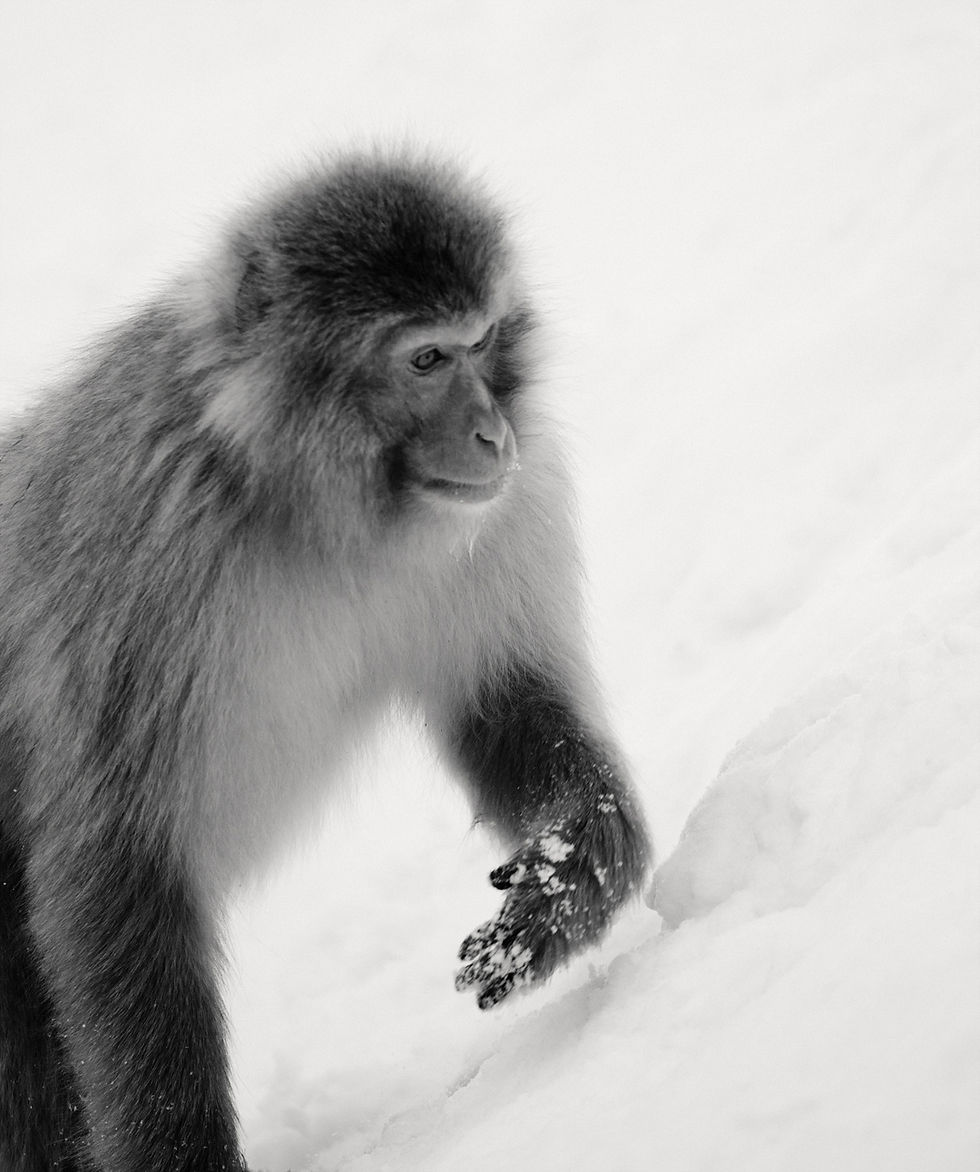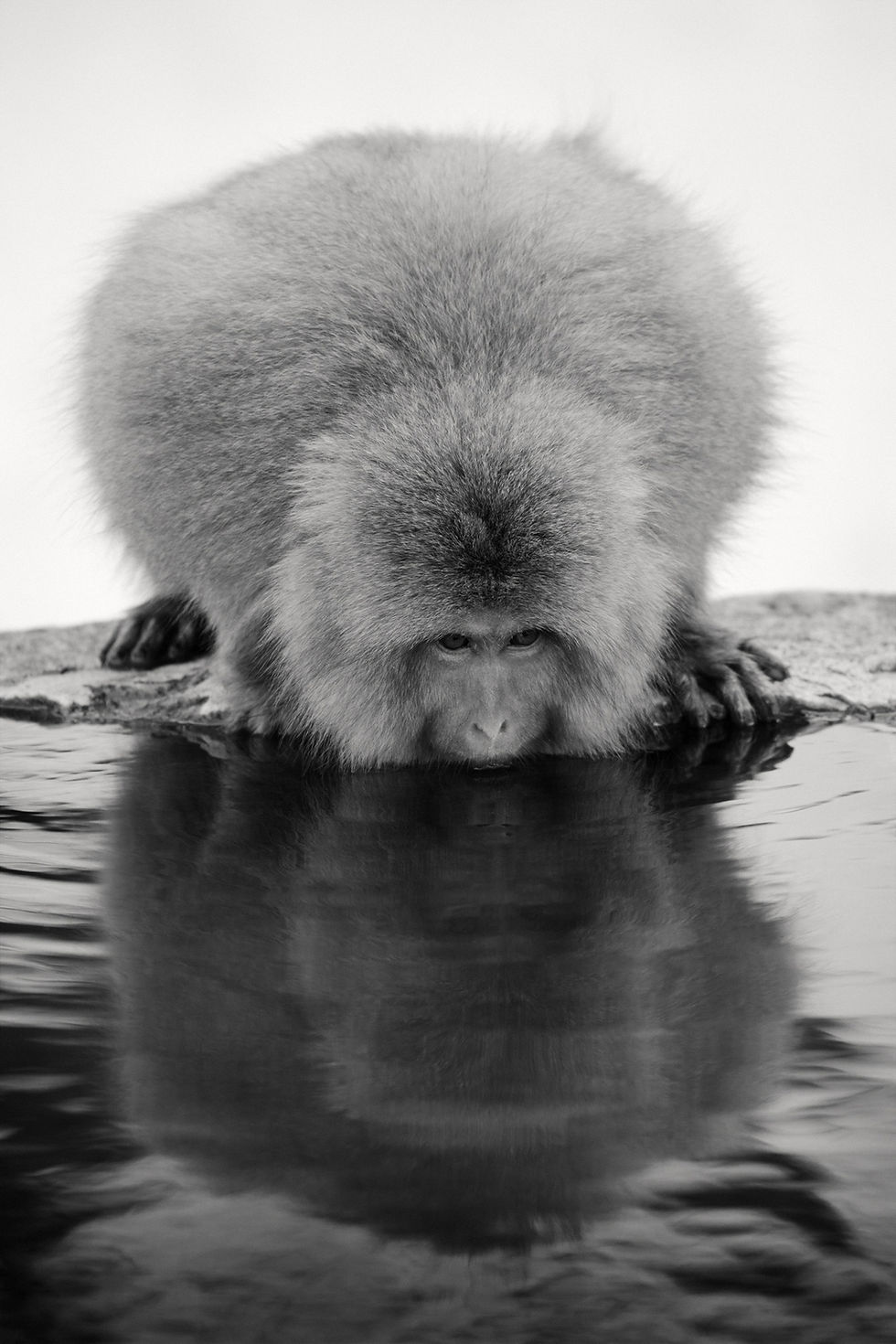Japan: Photographing the Snow Monkeys at Jigokudani Park in Nagano
- Olivier

- Feb 25, 2018
- 9 min read
Updated: Mar 23
Certainly, the monkeys of Nagano are among the most touristy places in Japan. Their legendary peculiarity of bathing in the hot springs during winter while striking typical poses makes them an exceptional sight not to be missed. As landscape photographers, should we ignore them and miss out on a unique experience? Certainly not.

© O. Robert
If you are planning a trip to Japan to photograph winter landscapes and find yourself in western Honshu, make sure to take a detour there. This unique encounter will certainly be an opportunity to capture some other iconic images of Japan. What are they, where and when to photograph them? Here are some answers based on my experience and curiosity.
Just like the Tanchozuru cranes in Hokkaido, the monkeys of Nagano offer a second chance to practice wildlife photography in Japan, even if you primarily consider yourself a landscape photographer. Your sensibility will find a new avenue for expression, and you will surely want to add your personal touch to the thousands of photos published each year on social media.
What are the Snow Monkeys
The "Snow Monkeys" of Nagano, officially known as Japanese macaques (Macaca fuscata), are an endemic species. This means that these monkeys are found only in this specific location. They inhabit a large area of the territory.
They are famous for their unique behavior of bathing in natural hot springs (onsen) during the winter months. They are located in the Jigokudani region, which is situated in the Yokoyu River valley, Nagano Prefecture. This area is particularly snowy in winter, hence the nickname "Snow Monkeys".
These monkeys are the most northerly living primates and are known for their intelligence and adaptability. Their distinctive behavior of bathing in hot springs was first observed in the 1960s. It quickly became a popular tourist attraction.

© O. Robert
They are about 60 cm tall and weigh around 15 kg when fully grown. Japan is the only country in the world where one can observe monkeys bathing in hot springs. The extreme negative temperatures (around -10°C is common) and heavy snowfall (over 1 meter) create ideal conditions for bathing in these warm waters. Their distinctive faces, expressions, and human-like behaviors make them a fascinating subject to observe.
The macaques bathe primarily to warm up during the winter months, but also for social and relaxation reasons. They exhibit several specific characteristics. Here are a few:
1. Adaptation to Cold: The macaques are one of the few primate species capable of surviving in cold climates. They have developed thick fur to withstand the harsh winter temperatures of this region in Japan.

© O. Robert
2. Social Hierarchy
The social structure of Japanese macaques is primarily matrilineal, meaning that female lineages determine the social rank. Daughters inherit their mother's rank, and sisters are ranked in order of their birth, with the eldest daughter being the highest-ranking.
Within a troop, there is a clear dominance hierarchy among both males and females. Higher-ranking individuals have priority access to resources such as food, mates, and grooming partners.
3. Communication
Snow Monkeys have a complex communication system that involves a combination of vocalizations, facial expressions, and body postures. Here is some useful information that it is preferable to remember when trying to photograph them up close.
Their coos and grunts are typically affiliative calls used to maintain social bonds and communicate friendly intentions. High-pitched screams are often associated with distress or alarm, alerting other group members to potential danger. Barks are aggressive vocalizations used to threaten or warn off other monkeys or perceived threats.
Opening the mouth wide to show teeth and is used to signal aggression or dominance. A rapid opening and closing of the lips, often used as a friendly or appeasing gesture. While it can indicate fatigue, yawning in macaques is also a display of tension or stress, often seen in dominant individuals.
4. Intelligence
These monkeys are known for their intelligence. Although they do not use tools as frequently as some other primate species, they have demonstrated the ability to learn and adapt their behavior to their environment (such as harsh winter conditions).
The Japanese macaques also have exceptional memory and cognitive abilities. They can remember the locations of food sources, recognize individual group members, and recall past social interactions.
How Many Snow Monkeys
There are no precise figures determining the number of macaques on a national scale. However, in specific locations like the Jigokudani Monkey Park in Nagano, the groups are generally well monitored. For instance, in Jigokudani, there are typically around 100 to 200 individuals in the local group.
It's important to note that these macaques are wild. Although they are accustomed to human presence in areas like Jigokudani Monkey Park, where they are a popular tourist attraction, they are not tamed.
Thus, they are completely free, but the food provided to them daily and the hot spring source are essential factors that motivate them to stay on site and return every winter.
Interactions between humans and monkeys are generally minimized to maintain their natural behavior and for the safety of both parties. Visitors to the park are encouraged to observe the monkeys from a distance and to follow established rules to avoid disturbing the animals.

© O. Robert
When to Photograph the Snow Monkeys
To observe the Snow Monkeys of Nagano, the most recommended period is obviously winter, especially from December to March. During these months, the temperatures are low, and the region is often covered in snow. This creates the iconic setting for which these macaques are known: bathing in the hot springs surrounded by a snowy landscape.
It is only during winter that the macaques bathe in the onsens to warm up, thus offering unique opportunities for photography and observation. They are also more active in winter, constantly searching for food and interacting with each other.
The steam from the water and the possible snowfall are optimal conditions for black and white photography (as is often the case). There is no need to visit on a sunny day or in another season. Even though you can see them, the monkeys are then far from the basin, and the high lights are not ideal.
However, it's good to note that the Jigokudani Monkey Park is open year-round, and the macaques can be observed in various behaviors and environments depending on the season. But for the classic experience of the Snow Monkeys in the onsen surrounded by snow, winter remains the best time.
It's important to respect their space and not to feed or touch them. This helps to maintain their natural behavior and avoid conflicts.
Although the Jigokudani Monkey Park is a popular tourist spot, it is perfectly organized to ensure perfect shooting opportunities. So don't hesitate, plan this interesting moment during your trip.

© O. Robert
How to Get to Jigokudani Park
Jigokudani Park was founded in 1964. It is located in Yamanochi and is easily accessible by road. It takes about 1 hour by car from Nagano Station (40 km). You can also get there by bus from Nagano Station. You have 2 options:
1. The Nagano Dentetsu Line Limited Express will take you to Yudanaka Station (40 minutes), where you will then take a bus to Shiga Kogen (15 minutes).
2. The Express Bus Shiga Kogen also departs from Nagano Station and takes you directly to Shiga Kogen, the terminus. From this site, you must continue on foot to Jigokudani Park.
However, if your goal is to photograph them at the best time, you will want to go by car. Indeed, it is important to arrive very early in the morning to be among the first at the ticket counter where you can buy your entrance ticket (800¥). The park opens at 9 am and closes at 4 pm in winter.
Surprisingly, the "park" is quite small. Certainly smaller than you might imagine. Therefore, it is imperative to arrive early to be able to set up at the location of your choice around the hot spring pool. The park is accessible by a walk through the forest, so good shoes and warm clothing in winter are recommended.

© O. Robert
You will notice from the size of the parking lots (located at Kanbayashi Onsen) that you will probably not be alone. They are massive (for cars and buses) and can accommodate the hundreds of thousands of visitors who come to this place each year. Many tourists also flock from all over the country by bus for day trips.
Consequently, the site is organized with various shops, restaurants, and cafes. From the parking area, it takes about a 30-minute walk on a forest trail to get to the park's entrance.
Plan to spend a maximum of half a day there, preferably in the morning. Around noon, the lighting is not very interesting anymore, and the shadow from the rocks in the background becomes too dominant. This is also when the park will be most crowded.
Address of the Jigokudani Park:
6845 Hirao, Yamanochi, Shimotakai District, Nagano 381-0401
And if you wish to warm up after a day of photography in the polar cold, I highly recommend staying in one of the many traditional homes or Ryokan in the Nagano region and make the most of the private hot springs. You will find the best references in this book:
What Equipment to Bring for Photographing the Snow Monkeys
Of course, it's up to each individual to bring the necessary equipment based on their expectations. But the distance between you and the monkeys is only a few meters, or even less if you are well-placed around the pool. Therefore, for portraits, a 50 mm or 80 mm lens are more than sufficient and perfectly suitable.
You can also move a bit higher up to try other interesting points of view of the pool. The site has a relief that also allows you to photograph them from a low angle. A telephoto lens or a zoom lens is then recommended.
Once out of the water, the monkeys run in all directions on the steep slopes around the source. Therefore, you need to have the right equipment to capture their high-speed movements. Smartphones will not really be able to capture these action scenes. The natural setting of rocks and snow is, meanwhile, ideal for perfect contrast.

© O. Robert
Black and White or Color
Even though excellent results can be achieved in black and white, Japanese macaques are characterized by the bright red color of their faces (especially more pronounced during the breeding season) and the subtlety of their fur. Although conventional, color photography is often more suitable for this subject if you don't have the appropriate lighting for black and white (white skies, no direct sunlight, etc.).
Young Snow Monkeys
With a bit of luck, you might also see litters of little ones (photo below). They are usually clinging to their mother's fur or under her belly, making them difficult to observe and photograph. From a very young age, they begin to frolic around innocently and fearlessly, under the watchful eye of their parents.
Plan to photograph them from a distance, as it is not easy to get close to them. Although peaceful most of the time, adult monkeys can become quite aggressive when it comes to defending their offspring.

© O. Robert
The Final Word
The unique behavior of the Nagano macaques and the way we observe them call for reflection on the interconnection between human beings and the wild world. The adaptation of these monkeys to the harsh climate and their almost cultural interaction with the hot springs highlight the ability of animal species to evolve and adapt.
Their existence, to the great pleasure of photographers, underscores our responsibility as protectors of these creatures and their habitat. The fascination they arouse, especially when bathing among snowy landscapes, is a mirror of our own quest for comfort, community, and well-being.
Nevertheless, the tourist attraction surrounding the Snow Monkeys raises questions about the ethics of our interaction with wildlife and our eagerness to photograph it. It invites us to reflect on how we can coexist with nature sustainably, preserving the delicate balance between admiration and human intervention.











